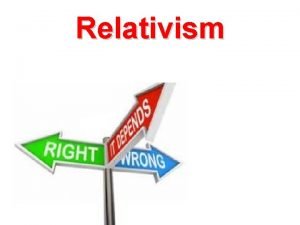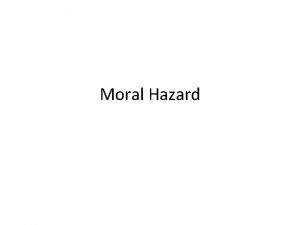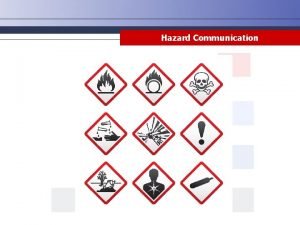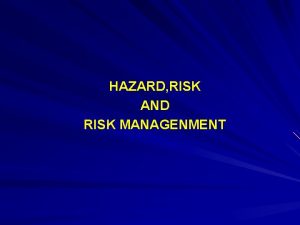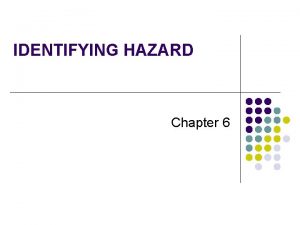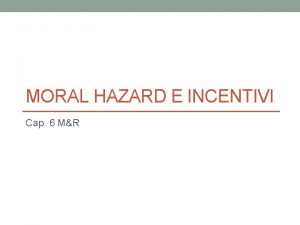Moral Hazard What Is Moral Hazard The term













- Slides: 13

Moral Hazard

What Is Moral Hazard • The term comes from the casualty insurance market. • A house may face a variety of fire hazards: it may be struck by lightning, it may burn because of faulty wiring, or it may be destroyed because the owner set it on fire to collect the insurance. • This last hazard is referred to as moral hazard.

What Is Moral Hazard • The terminology has carried over to health insurance in that it is assumed that individuals with a health insurance policy use more health services. • Of course, unlike the casualty market, there is nothing immoral about using more health insurance when you have coverage. • It is simply an application of the law of demand.

PED and Moral Hazard • Price elasticity is the economist’s rigorous way of quantifying the effect of a change in price on the change in quantity demanded. It is simply the percentage change in quantity divided by the percentage change in price. • Health services generally have a price elasticity of about – 0. 2. • This means that a 10 percent increase in the out-of-pocket price reduces the use of services by about 2 percent.

Moral Hazard in Healthcare

Different Effects of Price Change • Ambulatory mental health visits, for example, are much more price sensitive than are physician visits. • Dental care exhibits a large transitory effect not seen with other services, • Hospital care is much less price responsive than physician services. • Moreover, people with different opportunity costs of time have different responses to changes in out-of-pocket charges.

Moral Hazard in Healthcare The market price of a physician visit is $60, and the copay required of the insured is $20. For every visit between X 1 and X 2, the physician is paid more for the visit than the consumer’s demand curve says it is worth. Yet, subscribers rationally consume up to X 2. The triangle marked “Z” is the loss associated with this extra consumption. It reflects the expenditure made on behalf of the insured over and above the value of the service.

Predicted Annual Use of Medical Services Standard errors in parentheses. Unlike the ambulatory results, where reductions in use were seen across the range of coinsurance rates, with hospital use, the vast majority of the effect is found between the free and 25 percent plans. This result reflects the stoploss features of the plans

Predicted Annual Use of Medical Services • those who faced no out-of-pocket costs had average annual total medical expenditures of $3, 164. • This was 23 percent more than those who had to pay 25 percent of the bill and nearly 46 percent more than those who had to pay 95 percent (up to the stoploss). • Thus, substantially higher out-of-pocket prices result in meaningfully lower medical care expenditures.

RAND-HIE Elasticity Estimates for Health Services

Reduction in the Probability of Any Health Services Use, Free Care versus 25 Percent Coinsurance Rate, by Income Class

Why Moral Hazard Is A Problem • Moral hazard is a concern because it conflicts with risk-spreading goals. • Insurance is valuable because it allows people to transfer income from when they need it less to when they need it more. • But this transfer is not perfect because people increase their consumption of medical care when it is subsidized.

Thank You ! Any Question ?
 Moral hazard occurs when
Moral hazard occurs when Selezione avversa e azzardo morale
Selezione avversa e azzardo morale Moral hazard adalah
Moral hazard adalah League of nations international strife cartoon
League of nations international strife cartoon Moral individu dan moral kelompok
Moral individu dan moral kelompok Moral de esclavos y moral de señores
Moral de esclavos y moral de señores Bambrough moral scepticism and moral knowledge download
Bambrough moral scepticism and moral knowledge download Moral relativism
Moral relativism Define the term ethics and moral
Define the term ethics and moral Short-term and long-term goals examples
Short-term and long-term goals examples Nth term of a quadratic sequence
Nth term of a quadratic sequence Minterm and maxterm expansion
Minterm and maxterm expansion Short term planning and long term planning
Short term planning and long term planning Research paper on financial planning and forecasting
Research paper on financial planning and forecasting







